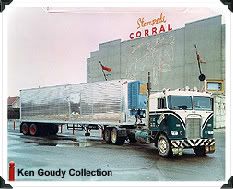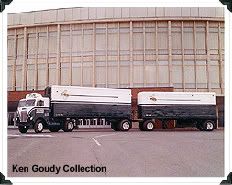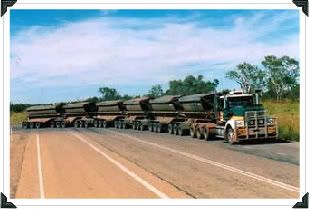 Road Trains!
Road Trains!
You might think that reducing fuel costs is a new thing which has been spurred on only in recent times by talk of the environment and increased oil prices -- but any freight company owner or manager who has any idea of keeping their business profitable has been interested in this all along. I can imagine that even in the days of the original teamsters -- the ones who drove and took care of teams of horses and possibly oxen -- kept their eyes on how many coins it cost to haul oats.
One of the ways that were used in bygone days -- probably before the days I remember of my Dad's trucking in the 60's and 70's -- was to pull more than one trailer with a tractor. When I say tractor, you would possibly say "truck" or perhaps "articulated lorry". "Tractor" being a term for the truck that pulls a "semi trailer truck unit". That basically means that the "trailer" doesn't have front wheels of its own, but instead rests its weight on the back axles of the "tractor". That is done through a pivoting plate called a "fifth wheel".
 Here is a shot of a "Semi" or "semi trailer truck" from the same company my Dad drove for many years ago in the 1970's. (image to right -- image from Ken Goudy's Collection)* I think most you are familiar with those sorts of rigs on the highways nearly anywhere in the world.
Here is a shot of a "Semi" or "semi trailer truck" from the same company my Dad drove for many years ago in the 1970's. (image to right -- image from Ken Goudy's Collection)* I think most you are familiar with those sorts of rigs on the highways nearly anywhere in the world.
Something that some might be less familiar with are multiple trailer or semitrailer units which are called different things in different places. In some places they are called "Road Trains" in others: "Truck Trains" "Doubles" "Triples" "Rocky Mountain Doubles" "Turnpike Doubles" "Turnpike Triples" "Queen City Triples". Those are some of the Canadian names for them, I guess legally they tend to be called Longer Combination Vehicles (LCVs), Extended Length Vehicles (ELVs), or Energy Efficient Motor Vehicles (EEMVs).
In Canada and the US you get A, B, and C-train variants which can be two and more rarely three trailer units. The three designations refer to how the trailers are attached to each other. Some places in Canada and the US allow them and some do not and there are differing restrictions as to just where and when they can travel; who can operate them; and how big they can get.
 In the first half of the 1970's and perhaps later '60's my Father drove A-train doubles through the Rocky Mountains between Calgary, AB and Vancouver, BC as well as A-train triples between Calgary and Edmonton, AB. He was driving for B-Line Express at the time though with a bit more modern equipment than in this picture of single axle tractor with twin pups. (image to left -- image from Ken Goudy's Collection)* Dad always drove a tandem tractor and often both trailers had tandem axles too -- although the converter had only the single axle if I recall correctly.
In the first half of the 1970's and perhaps later '60's my Father drove A-train doubles through the Rocky Mountains between Calgary, AB and Vancouver, BC as well as A-train triples between Calgary and Edmonton, AB. He was driving for B-Line Express at the time though with a bit more modern equipment than in this picture of single axle tractor with twin pups. (image to left -- image from Ken Goudy's Collection)* Dad always drove a tandem tractor and often both trailers had tandem axles too -- although the converter had only the single axle if I recall correctly.
 Dad mostly hauled hanging beef from Calgary to Vancouver. That meant a load of beef hanging in refrigerated trailers from the roof of the trailer on hooks. You have to keep in mind that the entire load hung from the ceiling of the truck and could swing. Dad just called them "A-trains" or "Doubles" at the time, but I think today they would call them "Rocky Mountain Doubles" like the one to the right. (image to right -- image from Rigs, part of Bear's Trucking Glossary)** The "Triples" might have looked something like this to the left.
Dad mostly hauled hanging beef from Calgary to Vancouver. That meant a load of beef hanging in refrigerated trailers from the roof of the trailer on hooks. You have to keep in mind that the entire load hung from the ceiling of the truck and could swing. Dad just called them "A-trains" or "Doubles" at the time, but I think today they would call them "Rocky Mountain Doubles" like the one to the right. (image to right -- image from Rigs, part of Bear's Trucking Glossary)** The "Triples" might have looked something like this to the left.  (image to left -- image from Rigs, part of Bear's Trucking Glossary)** I wasn't sure if the "pups" were single or tandem axle trailers.
(image to left -- image from Rigs, part of Bear's Trucking Glossary)** I wasn't sure if the "pups" were single or tandem axle trailers.
That was back in the 60's and 70's though and it was done because it was more efficient from the viewpoint of wages, equipment, and fuel. Perhaps you might recall there was an "energy crisis" back then too...
But that is history. Still history really isn't something to forget and really we are no different from people back then. (Some of us are people from back then.) Some of use were already environmentally conscious back then as well.
These "Truck Trains" or "Road Trains" are nothing compared with what they do in places like Australia. I don't mean everywhere in Australia. Their cities are no different than cities in Western nations anywhere else, they'd be too congested for even the shortest "trains". (There have been shown to be benefits to using short tractor-trailer units in cities rather than larger body-trucks/lorries though.)
 In the "Outback" just like in Canada's North long straight stretches beg for interesting transportation solutions. This is where "Road Trains" come into their own and where they really were invented... (image to right from 009's Car Blog) Though this is even just small compared to some of the record setting ones in Australia that I have read about in another blog:
In the "Outback" just like in Canada's North long straight stretches beg for interesting transportation solutions. This is where "Road Trains" come into their own and where they really were invented... (image to right from 009's Car Blog) Though this is even just small compared to some of the record setting ones in Australia that I have read about in another blog:  Youngistan - Incredible Road Trains!!!
Youngistan - Incredible Road Trains!!!
While more typical road trains might top out at 200 tonnes with the majority being between 80 and 120 tonnes - 80 - 120 being similar to Canadian and US sizes.
Monster trains in the outback in Guinness Book of Records in 1999 was for 45 trailers and 603t (601m long) in 2003 87 trailers (1,235m long) (no weight given) in 2006 112 trailers (1,474m long).
It all started out with someone buying a very powerful army surplus tractor and a bunch of army surplus "Bren-gun carriers" and wanting to carry more bulls across the outback.
Wikipedia - Road Train, History***
Australian Kurt Johansson is recognised as the inventor of the road-train. After transporting stud bulls 200 miles (320 km) to an outback property, Johansson was challenged to build a truck to carry 100 head of cattle instead of the original load of 20. Provided with financing of a couple thousand pounds to develop the vehicle, two years later his first road train was running.
Something different are the "Trackless Train" used in parking lots or fairgrounds for pedestrians or similar to the luggage trains in airports. There are also bus systems which actually put buses on track-like systems and articulated bus systems. But I will talk of them elsewhere.
It is a way to reduce the amount of fuel used in transporting goods on the highways, though it does take a bit of planning so that these long rigs can mix with other traffic.
Later!
~ Darrell
110
__________
* "Ken Goudy's Collection", Ken Goudy's Canadian Trucking Pictures -- Canadian Carrier Collection; "Hank's Web Site".
*** "Road Train" Wikipedia


 Stumble It!
Stumble It!

No comments:
Post a Comment